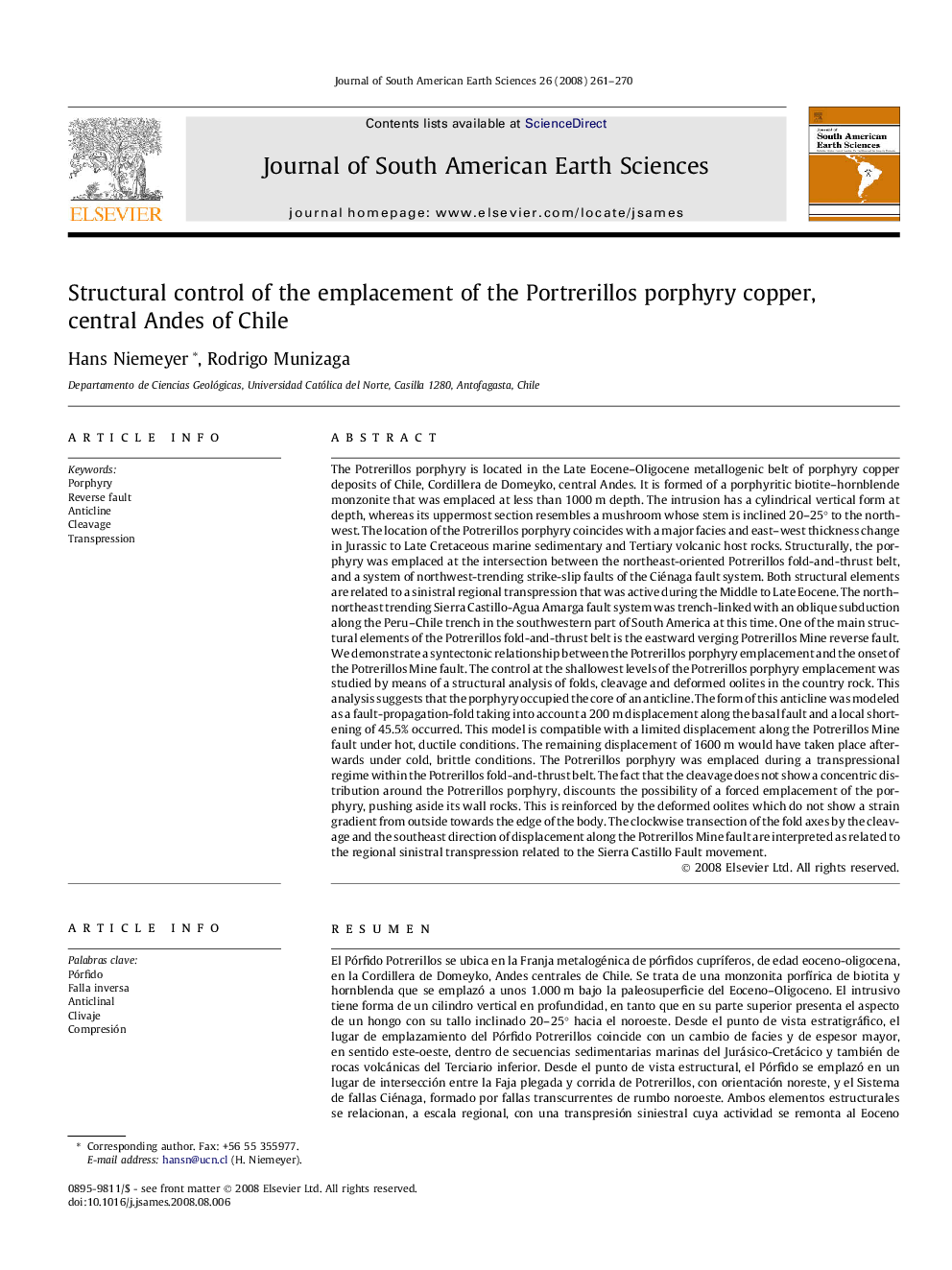| کد مقاله | کد نشریه | سال انتشار | مقاله انگلیسی | نسخه تمام متن |
|---|---|---|---|---|
| 4682704 | 1348936 | 2008 | 10 صفحه PDF | دانلود رایگان |

The Potrerillos porphyry is located in the Late Eocene–Oligocene metallogenic belt of porphyry copper deposits of Chile, Cordillera de Domeyko, central Andes. It is formed of a porphyritic biotite–hornblende monzonite that was emplaced at less than 1000 m depth. The intrusion has a cylindrical vertical form at depth, whereas its uppermost section resembles a mushroom whose stem is inclined 20–25° to the northwest. The location of the Potrerillos porphyry coincides with a major facies and east–west thickness change in Jurassic to Late Cretaceous marine sedimentary and Tertiary volcanic host rocks. Structurally, the porphyry was emplaced at the intersection between the northeast-oriented Potrerillos fold-and-thrust belt, and a system of northwest-trending strike-slip faults of the Ciénaga fault system. Both structural elements are related to a sinistral regional transpression that was active during the Middle to Late Eocene. The north–northeast trending Sierra Castillo-Agua Amarga fault system was trench-linked with an oblique subduction along the Peru–Chile trench in the southwestern part of South America at this time. One of the main structural elements of the Potrerillos fold-and-thrust belt is the eastward verging Potrerillos Mine reverse fault. We demonstrate a syntectonic relationship between the Potrerillos porphyry emplacement and the onset of the Potrerillos Mine fault. The control at the shallowest levels of the Potrerillos porphyry emplacement was studied by means of a structural analysis of folds, cleavage and deformed oolites in the country rock. This analysis suggests that the porphyry occupied the core of an anticline. The form of this anticline was modeled as a fault-propagation-fold taking into account a 200 m displacement along the basal fault and a local shortening of 45.5% occurred. This model is compatible with a limited displacement along the Potrerillos Mine fault under hot, ductile conditions. The remaining displacement of 1600 m would have taken place afterwards under cold, brittle conditions. The Potrerillos porphyry was emplaced during a transpressional regime within the Potrerillos fold-and-thrust belt. The fact that the cleavage does not show a concentric distribution around the Potrerillos porphyry, discounts the possibility of a forced emplacement of the porphyry, pushing aside its wall rocks. This is reinforced by the deformed oolites which do not show a strain gradient from outside towards the edge of the body. The clockwise transection of the fold axes by the cleavage and the southeast direction of displacement along the Potrerillos Mine fault are interpreted as related to the regional sinistral transpression related to the Sierra Castillo Fault movement.
ResumenEl Pórfido Potrerillos se ubica en la Franja metalogénica de pórfidos cupríferos, de edad eoceno-oligocena, en la Cordillera de Domeyko, Andes centrales de Chile. Se trata de una monzonita porfírica de biotita y hornblenda que se emplazó a unos 1.000 m bajo la paleosuperficie del Eoceno–Oligoceno. El intrusivo tiene forma de un cilindro vertical en profundidad, en tanto que en su parte superior presenta el aspecto de un hongo con su tallo inclinado 20–25° hacia el noroeste. Desde el punto de vista estratigráfico, el lugar de emplazamiento del Pórfido Potrerillos coincide con un cambio de facies y de espesor mayor, en sentido este-oeste, dentro de secuencias sedimentarias marinas del Jurásico-Cretácico y también de rocas volcánicas del Terciario inferior. Desde el punto de vista estructural, el Pórfido se emplazó en un lugar de intersección entre la Faja plegada y corrida de Potrerillos, con orientación noreste, y el Sistema de fallas Ciénaga, formado por fallas transcurrentes de rumbo noroeste. Ambos elementos estructurales se relacionan, a escala regional, con una transpresión siniestral cuya actividad se remonta al Eoceno medio a superior. La falla maestra en torno a la cual ocurrió dicha transpresión es la Falla Sierra Castillo-Agua Amarga, de rumbo norte-noreste. Se trata de una falla relacionada con la subducción oblicua a lo largo de la fosa chileno-peruana. Uno de los rasgos más prominentes de la Faja plegada y corrida de Potrerillos es la Falla inversa de la Mina Potrerillos que, con vergencia al este, desplaza al Pórfido Potrerillos. A nivel local, se ha demostrado una relación de sintectonismo entre la Falla inversa de la Mina Potrerillos y el emplazamiento del Pórfido. Se estudió el control estructural superior de éste mediante el análisis estructural de pliegues, clivaje y oolitas deformadas. Este análisis sugiere que el Pórfido Potrerillos se emplazó en el núcleo de un anticlinal. La forma de dicho anticlinal se modeló como un pliegue por propagación de falla, tomando en cuenta un desplazamiento de sólo 200 m a lo largo de la falla basal y un acortamiento local de 45.5%. El control estructural local del emplazamiento del Pórfido se debe al efecto de transpresión que afectó a toda la región de Potrerillos. El hecho de que la disposición del clivaje no sea concéntrica al pórfido excluye la posibilidad de que dicho cuerpo haya forzado la roca de caja hacia fuera. Esto se comprueba al constatar que las oolitas deformadas no muestran una variación sistemática su elipticidad desde afuera hacia adentro, en el entorno inmediato del pórfido. El clivaje transecto en sentido horario respecto de los ejes de los pliegues, a la vez que el desplazamiento al sureste de la Falla de la Mina Potrerillos indican la fuerte compresión relacionada con transpresión siniestral, a nivel regional, relacionada con el movimiento de la Falla Sierra Castillo.
Journal: Journal of South American Earth Sciences - Volume 26, Issue 3, November 2008, Pages 261–270